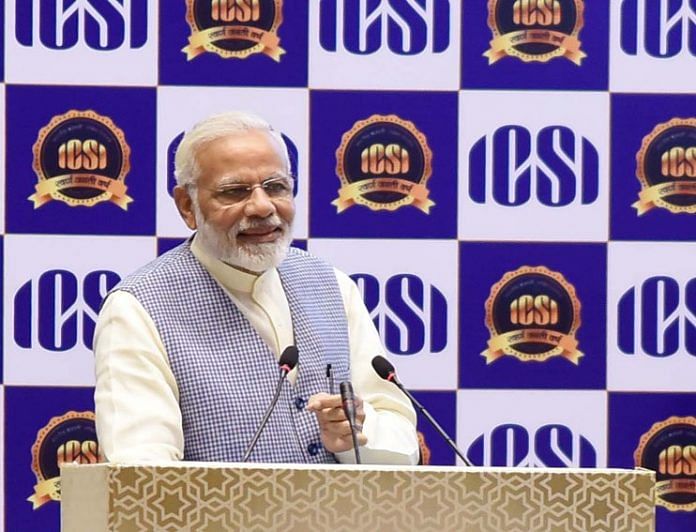Prime Minister Modi’s in a speech Wednesday promised to fight critics of the NDA’s economic policies. Defending GST and demonetisation, the Prime Minister argued that he may not be an economist, but a slump in the GDP for a quarter was not a harbinger of doom.
With data and slides, Modi stressed that his government had performed better than the previous UPA government and highlighted reforms implemented so far. The Prime Minister stressed on his government’s commitment to reforms and said it was ready to take decisions that would turn the economy around.
Question: Does Prime Minister Modi’s recent speech put to rest anxieties over India’s economy?
For the Modi government, there is no time for defensiveness or denial
 Milan Vaishnav
Milan Vaishnav
Senior fellow and director of the South Asia program at the Carnegie Endowment for International Peace
The PM’s recent speech defending his government’s economic programmes and pledging to arrest the slowdown in the economy could not have come sooner.
The first step in reversing the slumping economic trend is to accept you have a problem. While Modi acknowledged the country’s slumping growth in his speech, he refused to accept blame for other economic travails. For instance, Modi had little to say on the investment slowdown, which has festered for over three years now.
The government came to power believing it could grow the economy fast enough to minimise the twin balance sheet issue. This optimistic projection has not come to pass.
On demonetisation, Modi is banking on long-term gains, but the evidence to date suggests the government wildly miscalculated on the short-term economic gains. Thus far, notebandi has been a political winner rather than an economic one.
Finally, the GST roll-out has been rocky, to put it mildly. Over the long haul, the GST will be a net positive for the economy but the government must work overtime to fix the plethora of implementation roadblocks. For the Modi government, there is no time for defensiveness or denial. If it goes down that path, it will merely be repeating the sins of its predecessor.
Instead of indicating government’s response, Modi concentrated on comparisons with the last three years of the UPA
 Abhijit Sen
Abhijit Sen
Former member of the Planning Commission of India and currently professor of Economics in Jawaharlal Nehru University
Anxieties over the economy vary. At ground-level, the main issues remain farmer distress, lack of employment growth and fuel prices. But demonetisation and GST roll-out have also raised doubts over this government’s ability to manage the economy. It is these doubts which were aggravated when both Subramanian Swamy and Yashwant Sinha pointed to a continuing slow-down of GDP since January 2016 and warned of possible economic “tailspin” and “hard-landing”.
The Prime Minister’s speech at the Institute of Company Secretaries was clearly a response to the situation created by these seniors in his own parivar. Although Modi started by saying that he was not well versed in economics, the speech was mainly around a presentation on economic data which, significantly, had no mention at all of farmer distress, employment or fuel prices. It was aimed against “some people who sleep well only after they spread a feeling of pessimism all around”.
The main point of the speech was that GDP growth of single quarter (2017-18, Q1) should not be taken too seriously, especially when other indicators, including inflation, foreign exchange reserves, and deficits (both fiscal and on external current account) are presently better than what had been inherited from the UPA.
Such reassurances against a possible economic collapse was probably necessary. But, instead of acknowledging that problems do exist and indicating what government would do in response, the rest of the speech was simply comparison of the present with the last three years of the UPA. Since performance in those years was clearly bad and led to a rejection by the electorate, this is unlikely to restore belief in acche din.
The stage is now set for a slanging match over economic data (for instance, that almost all improvements claimed were during June 2014 to January 2016 when world oil prices fell from $110 to $30) instead of serious debate on economic policy (for example on fiscal stimulus as against interest rate cuts in the background of a seriously stressed banking sector).
The PM stuck to the political mantra that has worked for him– cede no ground to the opposition.
 Pranab Dhal Samanta
Pranab Dhal Samanta
Editor, ThePrint
First up, it may have come across as an emphatic state of the economy address by a Prime Minister whose government is under duress for its economic performance, but PM Narendra Modi’s 4 October speech went far beyond just that.
In fact, at the core of the PM’s address was a sharp political riposte, not an economic report card as many would say.
Despite the visible pressure on him, the PM stuck to the political mantra that has worked for him thus far — cede no ground to the opposition.
So, before offering any explanation or data, he set it up for the audience by first tearing into the opposition, his critics, and naysayers in his party.
He used the Shalya analogy from the Mahabharata to bunch them as negative minded opportunists, who tailor data to suit their arguments. Then, he picked on another familiar narrative peg of positioning himself as the ‘outsider’ to address the question of criticism by economist-reformers.
Here again, the PM did not cede an inch. He pulled out data from ‘when big economists ran this country’ to show how they fared. While he gave no context to those numbers, in that one sweep he made light of the likes of Yashwant Sinha and P Chidambaram, including, perhaps, even his predecessor Manmohan Singh.
As for data, Modi made it clear if they could produce negative data, he could produce just the opposite and paint a different picture.
While making no political concessions, he did leave the door open for considering any suggestions for improvement in the implementation of GST.
In other words, the PM let it be known that he’s willing to be flexible but at zero political cost.
The speech was probably Modi’s most significant political statement since 2013
 Shekhar Gupta
Shekhar Gupta






Modi has never made Mistates, nor he felt sorry for his deeds that may have brought misfortune for many. And this has been his life’s mantra. Bet anyone can prove otherwise?
Analysis is really good.presentpower is always blaming past. There exists no of problems,how to solve road map need to be published.
The answer to that question will lie in footfalls in shops for Diwali.